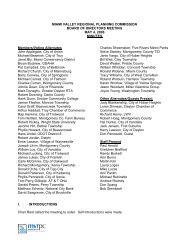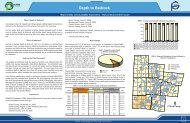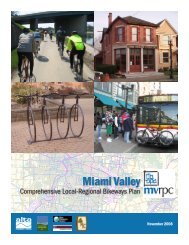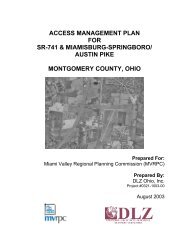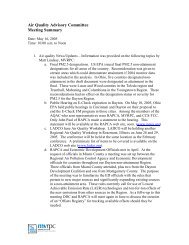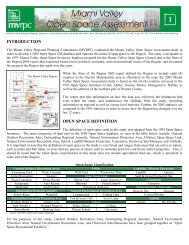MVRPC Draft Mission: - Miami Valley Regional Planning Commission
MVRPC Draft Mission: - Miami Valley Regional Planning Commission
MVRPC Draft Mission: - Miami Valley Regional Planning Commission
You also want an ePaper? Increase the reach of your titles
YUMPU automatically turns print PDFs into web optimized ePapers that Google loves.
<strong>Miami</strong> <strong>Valley</strong> <strong>Regional</strong><br />
<strong>Planning</strong> <strong>Commission</strong><br />
<strong>MVRPC</strong> <strong>Commission</strong> and Staff Retreat Summary<br />
Reflecting on the Past and<br />
Considering the Future<br />
Prepared by:<br />
Jim Kunde<br />
Fred Bartenstein and Associates<br />
Center for Urban and Public Affairs<br />
Wright State University<br />
March 1, 2003<br />
1
<strong>MVRPC</strong> <strong>Commission</strong> and Staff Retreat Summary<br />
March 1, 2003<br />
It is the right time to renew the strategic direction for the <strong>Miami</strong> <strong>Valley</strong> <strong>Regional</strong> <strong>Planning</strong><br />
<strong>Commission</strong> (<strong>MVRPC</strong>). Private, public, and nonprofit leaders seek an organization to help build<br />
a common vision and voice for the region; <strong>MVRPC</strong> has new executive leadership; regionalism is<br />
coming of age—for example, it is how we are defined in the global economy. The intent of the<br />
<strong>MVRPC</strong> <strong>Commission</strong> retreat on March 1, 2003 was to develop, through a deliberative,<br />
consensus building process, the strategic direction of <strong>MVRPC</strong> to the year 2010.<br />
PART ONE: ACKNOWLEDGING OUR PAST, LOOKING TO THE FUTURE<br />
As background information for the day’s event, <strong>Commission</strong> members received an overview<br />
from several sources.<br />
Acknowledging our Past<br />
• Powers and duties of <strong>Regional</strong> <strong>Planning</strong> <strong>Commission</strong>s, Metropolitan <strong>Planning</strong><br />
Organizations (MPOs), and Councils of Government (COGs) (see Appendix A)<br />
Looking to the Future<br />
• An overview of other COGs in Ohio (see Appendix B)<br />
• <strong>Regional</strong> leaders’ consensus ideas for next steps (see Appendix C)<br />
• Highlights from <strong>Commission</strong> and Staff members’ interviews (see Appendix D)<br />
PART TWO: CREATING A VISION AND NEXT STEPS<br />
Part two of this report presents the planning results from the retreat. Topics presented in this<br />
section are the mission statement, the vision statement, and strategic priorities.<br />
Our <strong>Mission</strong><br />
The planning activity of the retreat began with a review of a staff-drafted mission statement:<br />
A forum and resource for regional interests to develop public policy,<br />
collaborative strategies, plans, and programs that improve the quality of life<br />
and economic vitality throughout the <strong>Miami</strong> <strong>Valley</strong><br />
Slogan: One Region…One Vision…One Future<br />
<strong>Commission</strong> members were asked to react to the mission statement by describing what they liked<br />
and didn’t like about it. The two lists (below) present some of the same elements, because the<br />
same element was liked by some and disliked by others. We used this input to build toward a<br />
refined mission statement by answering the questions, “Who do we serve, what is our purpose,<br />
and what impact do we seek to make?”<br />
1
What do you like about the draft mission?<br />
• <strong>Miami</strong> <strong>Valley</strong><br />
• forum<br />
• resource<br />
• collaborative<br />
• it is clear<br />
• The slogan<br />
• future<br />
Who do we serve?<br />
• Public – the citizens<br />
(broadly defined) are<br />
our ultimate<br />
constituency<br />
Governments<br />
• “The region”<br />
• Corporate citizens, small<br />
businesses, nonprofits,<br />
and other<br />
structures are also<br />
citizens<br />
• “Who we represent” is<br />
too narrow a focus.<br />
We need to broaden it.<br />
What do you dislike about the draft mission?<br />
• <strong>Miami</strong> <strong>Valley</strong><br />
• forum<br />
• resource<br />
• placement of “collaborative” -- put it first<br />
• it is unclear<br />
• public policy<br />
• improve<br />
• lacks how to implement<br />
What is our purpose?<br />
• Facilitate<br />
• Develop<br />
• Implement<br />
o Educate about<br />
regional issues<br />
o Provide expertise and<br />
information resources<br />
o Secure funding<br />
• Lead<br />
What impact (results) do we<br />
hope to achieve?<br />
• Cohesive region<br />
• Improved quality of life,<br />
that may be defined as<br />
economic, social,<br />
environmental, and<br />
mobility<br />
• Improved<br />
intergovernmental<br />
relationships<br />
• Economic development<br />
for the region<br />
• Enhanced environment<br />
Summary of why <strong>MVRPC</strong> does what it does…<br />
To bring consensus to the region and to build and conserve social and environmental capital<br />
Potential Revised <strong>Mission</strong> Statement<br />
<strong>MVRPC</strong> facilitates, develops, and implements collaborative strategies to<br />
enrich the quality of life for citizens of the Greater Dayton Region<br />
Our Vision<br />
While the mission statement asserts why the organization exists, the vision statement articulates<br />
what the organization seeks to become. The statement should be inspirational. <strong>Commission</strong> and<br />
staff members in attendance were organized into three groups to brainstorm a vision statement<br />
for <strong>MVRPC</strong>. The participants were asked to envision that it is the year 2010 and they are talking<br />
to a reporter about <strong>MVRPC</strong> and what it has accomplished. They were also asked to think about<br />
what the organization might accomplish with hard work, reasonable luck, but no miracles.<br />
Comments from the three groups were placed side by side, and common themes were identified.<br />
2
Consensus concepts for <strong>MVRPC</strong>’s Vision Statement<br />
• A “servant leader” to the region<br />
• Focal point for collaboratively addressing local issues; a forum<br />
• Clearinghouse/collaborate/coordinate<br />
• The lead and/or partner in regional lobbying efforts that frame issues as “Win/Win”<br />
• The region’s voice on policies and priorities<br />
• Building bridges to improve the quality of life/ acknowledges our interdependence<br />
• The <strong>Commission</strong> is more diverse/inclusive/representative (e.g. minorities, schools,<br />
townships). Membership contains a strong core of regional thinkers who are open and<br />
accessible, not “Big Brother”.<br />
• Skills/capacity: strong staff, data clearinghouse, technology transfer, information center<br />
• Facilitator/builder of regional competitiveness (e.g. education, economic development,<br />
natural resources)<br />
• Effective in implementation: continued strong transportation, linked with water, land use,<br />
air quality, jurisdictional cooperation.<br />
• Role model for regional collaboration, all about alliances and connection: common goals<br />
in uncommon ways.<br />
Potential Vision Statement<br />
The <strong>Miami</strong> <strong>Valley</strong> <strong>Regional</strong> <strong>Planning</strong> <strong>Commission</strong> is an influential force in Ohio (and beyond)<br />
as the region’s voice on policies and priorities. Its strong core of regional thinkers has become a<br />
model and forum for regional collaboration, and is supported by a strong staff and expert systems<br />
to support decision making. A synthesis of leadership and information positions the organization<br />
to continually align and realign its mission with the emerging needs of the region.<br />
Priority Strategies<br />
<strong>Commission</strong> and staff members in attendance were again organized into three groups. They<br />
brainstormed the strategies needed to move <strong>MVRPC</strong> from where it is today to where it wants to<br />
be in the future (i.e., toward its vision). Each of the three groups identified its own priority<br />
strategies (see the addendum to this report), and then each group’s priorities were compared to<br />
the others. This comparison resulted in five strategic priorities for <strong>MVRPC</strong>:<br />
• Communicate and market the vision, mission, and strategies to stakeholders (e.g.,<br />
citizens). Promote the benefits of <strong>MVRPC</strong>, develop an agency image, and educate<br />
stakeholders.<br />
• Develop an issues committee to identify regional priorities on a regular basis. The<br />
committee should include private sector representation, and should hold regular, formal<br />
meetings with editorial boards and state and federal officials.<br />
• Create measurements (benchmarks) to report progress and evaluate and disclose<br />
performance. Review progress toward strategies every six months.<br />
• Examine and improve the structure and composition of the <strong>Commission</strong>. Use guiding<br />
principles to communicate <strong>MVRPC</strong> expectations to <strong>Commission</strong> members. Ensure that<br />
3
key players are at the table for important decisions. Develop a process for involving<br />
county-level officials from Warren and Clark counties.<br />
• Develop, in a consensus manner, a regional comprehensive plan and a regional growth<br />
management strategy that balances protection of natural resources and development (a<br />
high priority in two of the three groups).<br />
4
Group A<br />
ADDENDUM<br />
<strong>Commission</strong> and Staff Strategies<br />
Developed at the March 1, 2003 Retreat<br />
Strategies (in order of greatest interest):<br />
• Develop a regional comprehensive plan, addressing air quality, water, transportation, and<br />
land use. This comprehensive plan should be accomplished in a consensus manner,<br />
balancing protection of natural resources and development<br />
• Develop an issues committee to identify regional priorities (the committee may be<br />
comprised of two members from <strong>MVRPC</strong>, 2 from the Dayton Development Coalition,<br />
and so on).<br />
• Benchmark critical issues topics.<br />
• Develop guiding principles for jurisdictions to agree to (an example of a guiding<br />
principle might be, “We’ll be active participants to discuss regional issues”).<br />
• Go out to <strong>MVRPC</strong>’s constituencies with the refined vision describing what <strong>MVRPC</strong> will<br />
do and why and how it will strategically achieve the vision.<br />
o Educate constituencies.<br />
o Develop an agency image.<br />
o Promote the benefits of being a member of <strong>MVRPC</strong>.<br />
• Examine the structure of <strong>MVRPC</strong>’s commission as well as its composition. (Strategize<br />
about how groups outside of the commission will be accessed and their input obtained.)<br />
o Consider what structure makes sense for today.<br />
• Consider the methods (such as survey or face-to-face meetings) that will be used to<br />
contact constituencies to review the <strong>MVRPC</strong> vision and to formulate strategies. Check in<br />
with constituencies (including voters) about vision and strategies. It gives the message,<br />
“You’re important to us.”<br />
• Train elected officials via a governance academy.<br />
• Utilize the positive situation of congressional support to create the urgency of need to<br />
collaborate--this is the time.<br />
• Select a project, develop it successfully and then market it as a regional success.<br />
o Build momentum.<br />
• Develop and maintain state of the art technology.<br />
o Use our data and numbers to convince people about issues and criticality.<br />
Group B<br />
Strategies (in order of greatest interest):<br />
• Convene regional groups based on issues (e.g., GIS, basin council) periodically, not just<br />
in crisis.<br />
• Identify individual and specific tangible benefits of regionalism, and educate<br />
stakeholders.<br />
• Overcome issues in the region that threaten and compete with each other (e.g.,<br />
competition for state dollars).<br />
5
• Make sure key players are at the table for important decisions that affect them.<br />
• Identify, recruit and involve “regional thinkers.”<br />
• Bring our views and outside agencies’ (federal, state, chamber, RTA) input into<br />
alignment.<br />
• Work better with other agencies. Fill gaps, don’t duplicate efforts.<br />
• Obtain funding for projects.<br />
• <strong>Commission</strong> members must stop undermining decisions that have been made.<br />
<strong>Commission</strong> members need to live with, rather than revisit, final decisions.<br />
• Don’t take votes on the same night an issue is raised, unless it is on the agenda and there<br />
has been time to get stakeholder input.<br />
• Get the various entities to agree to agree.<br />
• Develop a system for “listening” and gathering input on issues.<br />
• Vitalize the membership base toward a “one for all” mentality through leadership and<br />
follow-through.<br />
• Establish better partnerships to develop resources.<br />
• Seek win-win solutions (compensation may be needed).<br />
• Review, revise and update membership requirements.<br />
• Establish objectives and benchmarks. Evaluate and disclose performance.<br />
• Keep getting out information on successes; improve public relations.<br />
• Identify stakeholders. Build mutual respect and trust.<br />
• Make participation easy.<br />
Group C<br />
Strategies (in order of greatest interest):<br />
• Implement relationships with county level officials in Warren and Clark counties.<br />
• Define and create specific indicators to measure progress toward achieving initiatives.<br />
• Reach out to the education community to bring that community into the planning process.<br />
• Communicate and market the vision, mission and strategies to stakeholders (e.g.,<br />
citizens), implement, and measure, then check back in with stakeholders and regularly<br />
communicate status to stakeholders.<br />
• Score an early success:<br />
o Regarding lobbying, the transportation Capital Acquisition Model can be used as<br />
a model for other areas.<br />
• Develop a regional growth management strategy.<br />
• Hold regular, formal and informal, meetings with state and federal officials<br />
• Attract active, committed members to be able to achieve goals.<br />
o Make it the will of the organization to achieve our goals.<br />
o Have active members approach and recruit inactive members.<br />
o Reach out to other governmental leaders and citizens.<br />
• Develop a legislative and regulatory agenda to empower comprehensive regional<br />
planning.<br />
• Provide staff the necessary funds to achieve our goals.<br />
• Hold formal, informal and regular meetings with private sector organizations to share<br />
economic development goals between board and staff.<br />
6
• Hold regular and formal meetings with editorial boards on regional economic<br />
development issues.<br />
• Expand boundaries to reflect the current census defined urbanized areas.<br />
• Create and empower regional organizations to represent all of us to achieve desired<br />
results for the region at the state and federal level.<br />
• Assign every member community a member service contact. Be a first line of contact for<br />
member community.<br />
• Focus on top regional infrastructure and economic development priorities.<br />
• Carry out an educational program for high level staff and elected officials on the mission<br />
of <strong>MVRPC</strong>.<br />
• Continue programming (e.g., <strong>Regional</strong> Issues Forum—bring in national experts on issues<br />
the region is facing to create visibility).<br />
• Test a model of granting legislative authority on a regional level (specific, limited issues).<br />
• Regular review of strategies every six months.<br />
o Form an educational advisory committee<br />
7
APPENDIX A<br />
Powers and Duties of <strong>Planning</strong> Organizations<br />
<strong>Regional</strong> <strong>Planning</strong> <strong>Commission</strong><br />
The commission makes maps, studies, plans, and develops recommendations and reports<br />
concerning the physical, environmental, social, economic and governmental characteristics,<br />
functions, services, and other aspects which affect the development and welfare of the region.<br />
Metropolitan <strong>Planning</strong> Organization (MPO)<br />
An MPO determines the best mix of transportation investments to meet metropolitan<br />
transportation needs. Also it protects and enhances the environment, improves the transportation<br />
system and plans for the future of the transportation system.<br />
<strong>Regional</strong> Councils of Governments (COGs)<br />
COGs coordinate actions among and between their members and other agencies. They also act<br />
as an area-wide agency to perform comprehensive planning for the region, relative to financing,<br />
scheduling of public policies, development, and public facility projects.<br />
8
Columbus, OH<br />
APPENDIX B<br />
Benchmark <strong>Regional</strong> <strong>Planning</strong> Organizations<br />
Mid-Ohio <strong>Regional</strong> <strong>Planning</strong> <strong>Commission</strong> (MORPC)<br />
www.morpc.org<br />
<strong>Mission</strong>:<br />
To enhance the quality of life and competitive advantages of the region by working through local<br />
governments and other constituents.<br />
Slogan: “Working to Build a Better Region”<br />
Programs & Services:<br />
• Consulting Services: Accounting, Public Affairs, Human Resources, Information<br />
Technology and Software <strong>Planning</strong><br />
• Data & Information Technology Services: Aerial Photography, Geographic Information<br />
System, Land Use Demographics, Transportation & Census Data, Traffic Volumes<br />
• Housing/Weatherization: Home Ownership Counseling, Housing Rehabilitation Program,<br />
Leadsafe Franklin Co. Program, Residential Energy Conservation, Revenue Bonds<br />
Program<br />
• Infrastructure Funding and <strong>Planning</strong>: Clean Ohio Fund, SCIP/LTIP Infrastructure<br />
<strong>Planning</strong>, Transportation Improvement Program<br />
• Legislative Services<br />
• <strong>Planning</strong> for a Livable Region: Central Ohio Ozone Action Program, Greenways,<br />
Pedestrian & Bikeways <strong>Planning</strong>, 2002 <strong>Planning</strong> & Zoning Workshop, Rideshare,<br />
Vanpool, Carpool, Seven County Growth Strategy<br />
Cincinnati, OH<br />
OKI (Ohio Kentucky Indiana <strong>Regional</strong> Council of Governments)<br />
www.oki.org<br />
<strong>Mission</strong>:<br />
OKI is a council of local governments, business organizations and community groups committed<br />
to developing collaborative strategies, plans and programs which will improve the quality of life<br />
and the economic development potential of the Tri-state.<br />
Together they work to solve interstate dilemmas, create far-reaching development plans, break<br />
through political bureaucracy, and provide services to the public and advocate for federal<br />
funding. By focusing the collective strengths of organizations from around the region, OKI has<br />
accomplished more in the Tri-state in terms of growth, development and quality-of life<br />
improvements than any other entity or group of entities. Their impact is seen and felt in nearly<br />
every major project being undertaken in the region. These projects continue to support OKI's<br />
mission of promoting regional growth now and in the new millennium.<br />
9
Programs & Services<br />
• Transportation <strong>Planning</strong><br />
• Land use <strong>Planning</strong><br />
• <strong>Regional</strong> Greenspace <strong>Planning</strong><br />
• <strong>Regional</strong> Ozone Coalition<br />
Asheville, NC<br />
Land-of-Sky <strong>Regional</strong> Council<br />
www.landofsky.org<br />
<strong>Mission</strong>:<br />
Work with local governments, the Region’s leadership and state and federal agencies to foster<br />
desirable social, economic, cultural and ecological conditions in Buncombe, Henderson,<br />
Madison and Transylvania Counties.<br />
Programs & Services:<br />
• Land Use and Transportation <strong>Planning</strong><br />
• Economic Development<br />
Louisville, KY<br />
Kentuckiana <strong>Regional</strong> <strong>Planning</strong> and Development Agency (KIPDA)<br />
www.kipda.org<br />
Programs & Services:<br />
• <strong>Planning</strong>, review and technical services in the areas of public administration, social<br />
services and transportation<br />
• Community Ridesharing programs<br />
• KIPDA also coordinates services for persons 60 years of age and over<br />
Minneapolis/St. Paul<br />
Metropolitan Council<br />
www.metrocouncil.org<br />
<strong>Mission</strong>:<br />
The Metropolitan Council is the regional planning agency serving the Twin Cities seven-county<br />
metropolitan area and providing essential services to the region. The Council works with local<br />
communities to provide many critical services.<br />
10
Programs & Services:<br />
• Operates the region's largest bus system<br />
• Collects and treats wastewater<br />
• Engages communities and the public in planning for future growth<br />
• Provides forecasts of the region's population and household growth<br />
• Provides affordable housing opportunities for low- and moderate-income individuals and<br />
families<br />
• Provides planning, acquisitions and funding for a regional system of parks and trails<br />
Winston-Salem, NC<br />
Northwest Piedmont Council of Governments<br />
www.nwpcog.dst.nc.us<br />
<strong>Mission</strong>:<br />
The mission of the Northwest Piedmont Council of Governments is to assist its members in<br />
meeting the needs of their citizens by nurturing regional cohesiveness; providing leadership in<br />
identifying issues and in reaching solutions; being proactive in building on our strengths and<br />
opportunities; and bridging the responsibilities of the federal, state and local governments as the<br />
Lead <strong>Regional</strong> Organization (LRO).<br />
Programs & Services:<br />
• Workforce training<br />
• Emergency medical services<br />
• Housing assistance<br />
• Criminal justice<br />
• Economic Development<br />
• Technical assistance<br />
Greensboro, NC<br />
Piedmont Triad Council of Governments<br />
www.ptcog.org<br />
<strong>Mission</strong>:<br />
The Piedmont Triad Council of Governments (PTCOG) is a voluntary association of local<br />
governments - urban and rural - authorized by state law to: make and implement joint regional<br />
decisions; provide management, planning and technical services to local governments; identify<br />
and solve short and long-term problems best addressed at the regional level; and to bring<br />
together local elected officials on a regular basis, giving them an opportunity to form working<br />
relationships.<br />
11
Programs & Services:<br />
• Prepare land use plans, zoning ordinances, and annexation studies<br />
• Provide personnel classification, pay studies and personnel policies<br />
• <strong>Regional</strong> Data Center for member governments and a variety of private sector clients<br />
• Manage regional telecommunications program which helps member governments<br />
regulate cable TV rates, negotiate franchise agreements and keep abreast of emerging<br />
telecommunications issues<br />
• Emergency medical services planning and training<br />
• Play role in regional organizations such as the Piedmont Triad Partnership, Piedmont<br />
Triad Farmers' Market, and Piedmont Authority for <strong>Regional</strong> Transportation<br />
• Administer the Area Agency on Aging - adult day care, care management, transportation,<br />
congregate and home-delivered meals, and ombudsman services for residents of rest and<br />
nursing homes<br />
12
APPENDIX C<br />
<strong>Regional</strong> Leaders’ Consensus Ideas for Next Steps<br />
On January 29, 2003, the <strong>Miami</strong> <strong>Valley</strong> <strong>Regional</strong> <strong>Planning</strong> <strong>Commission</strong> (<strong>MVRPC</strong>) convened a<br />
group of regional leaders (47 were in attendance) to discuss a vision for and strategies to improve<br />
the Greater Dayton region. <strong>Regional</strong> leaders came together to rethink what <strong>MVRPC</strong> could be<br />
doing and perhaps should be doing given this regional context.<br />
CREATING A VISION AND NEXT STEPS<br />
Having interviewed 97 leaders individually, we convened them for a group discussion about our<br />
region’s future. <strong>Regional</strong> leaders were organized into three breakout groups. Leaders were asked<br />
to provide comments on how they define the “<strong>Miami</strong> <strong>Valley</strong> region,” to discuss a vision for our<br />
region, and to identify strategic priorities. The intent of the breakout session was not necessarily<br />
to come to agreement on a vision and strategies for the region, but rather to discuss the vision<br />
and identify topics of consensus and topics of disagreement. This appendix presents identified<br />
consensus issues, and a discussion of the regional vision and strategic priorities.<br />
Toward a <strong>Regional</strong> Agenda<br />
• We need to develop a shared vision and voice, and lobby purposefully to obtain funding<br />
for strategic priorities.<br />
• The day’s event, itself, pointed to the need for a forum or venue to discuss regional<br />
priorities and issues in an ongoing manner. (However, convening the forum and<br />
implementing activities on behalf of the region are clearly two separate roles.)<br />
• We need to identify the benefits for drawing in desired partners and design partnerships<br />
to be win/win.<br />
• We need to look toward forming strategic alliances with Cincinnati where each side has<br />
relatively equal strengths thus forming an equal partnership.<br />
Geography of Influence<br />
• The name and geography of the region impact our ability to present a shared vision and<br />
voice.<br />
• The geographic definition of the Greater Dayton area should be fluid, drawing in natural<br />
partners who are compelled to participate by the apparent benefits.<br />
• The label, “<strong>Miami</strong> <strong>Valley</strong>,” is a confusing marketing handle; “Dayton” is a more<br />
recognizable name and is more easily geographically referenced.<br />
13
The Role of <strong>MVRPC</strong><br />
• There is a need to reaffirm and perhaps redesign the mandate for <strong>MVRPC</strong> and to<br />
reconsider its role in relation to other entities and efforts.<br />
• <strong>MVRPC</strong>’s direct influence is considered to be in transportation and environmental<br />
planning. (<strong>MVRPC</strong> had a broader mission in the past. Today, regional leaders support a<br />
reconsideration of <strong>MVRPC</strong>’s currently narrower mission.)<br />
• The public, private, and nonprofit sectors need to be represented in the process of<br />
realigning <strong>MVRPC</strong> to today’s regional planning needs.<br />
• Given the need for collaborative lobbying, <strong>MVRPC</strong> could function as the region’s<br />
clearinghouse for leveraging funds, legislation, and other regional issues, beyond<br />
transportation and the environment.<br />
Our Vision<br />
The vision for the region is not clear—it’s being recast on a dry-erase board. Yet, the central<br />
common theme, in personal interviews and in the event held with regional leaders, is successful<br />
economic development. Private sector leaders tend to focus on the effects of radically changing<br />
market conditions and the consequences thereof, while public sector leaders focus on the role of<br />
local government in the economic development process, noting the importance of balancing<br />
collaboration (such as shared revenue and shared service delivery) and autonomy.<br />
More specifically, regional leaders would like the region to become less dependent on WPAFB<br />
and the automotive industry in the future and more proactive in attracting and creating its own<br />
diverse array of employment sectors, such as the Information Technology (IT) industry. In fact,<br />
developing a world class entrepreneurial infrastructure for IT and other industries was a strong<br />
theme in two of the break-out groups. Education is an important component of this vision,<br />
especially in relationship to education’s role in supporting economic development by providing<br />
top-notch education to the region’s youth and instilling the workforce needs of employers.<br />
Another common belief was that Dayton ought to be the economic and cultural center of the<br />
region, able to provide entertainment activities, shopping, living-wage employment, and<br />
adequate housing. Leaders also desire that the region become recognized as a model region,<br />
with inter-governmental cooperative relationships amongst all townships, cities, and villages.<br />
One important outcome of cooperative relationships should be the preservation of valuable<br />
farmland, primarily in the region’s western portion.<br />
Identifying Strategic Priorities<br />
While the three groups of leaders on January 29 th did not identify a list of strategic issues for<br />
which there was overall consensus, there were some more popular strategies identified. Support<br />
was articulated for a region-wide revenue sharing program similar to Montgomery County’s<br />
ED/GE program; a regional industry/sector targeting and marketing plan; developing a<br />
consensus organization (perhaps <strong>MVRPC</strong>) to create a regional land-use plan to work in concert<br />
with the regional transportation plan; lobbying the State to provide incentives for regions that<br />
exhibit regionalism; and pooling regional resources to assist schools that are under-performing.<br />
14
A consensus does exist for the context in which strategic issues should be addressed. Clearly,<br />
leaders agree that the region needs to identify manageable priorities where a common voice is<br />
essential. Leaders also concurred that, while regional planning efforts have been well done,<br />
implementation has often floundered. They attribute this to a lack of definition of measurable<br />
outcomes, a lack of reporting progress to the community, and the absence of an integrating<br />
regional organization that assesses the impact of one strategic area upon another and that aligns<br />
and realigns resources as contexts change.<br />
15
Chuck Abramovitz *<br />
Woolpert<br />
Steve Austria *<br />
State of Ohio Representative<br />
Jewel Bartels *<br />
Preble County Family & Children First<br />
Council<br />
Fred Bartenstein ***<br />
Fred Bartenstein Associates<br />
David Bohardt **<br />
HBA of Dayton<br />
Tom Breitenbach *<br />
Premier Health Partners<br />
Steve Bruns *<br />
Tipp City Chamber of Commerce<br />
Ron Budzik<br />
Mead Westvaco Corp.<br />
Kevin Burch **<br />
Jet Express<br />
Charles Cochran *<br />
Troy Chamber of Commerce<br />
Randy Cole **<br />
Preble County Chamber of Commerce<br />
Dave Collinsworth **<br />
Tipp City<br />
Blair Conrad *<br />
Dayton International Airport<br />
Warren Copeland *<br />
City of Springfield<br />
<strong>Regional</strong> Leader Participants<br />
Bruce Cornett *<br />
Green Environmental Coalition<br />
Charles Curran<br />
Montgomery County<br />
Dave Daily *<br />
City of Eaton<br />
Mandy Daniels *<br />
Darke County Farm Bureau<br />
Dale Dempsey<br />
Dayton Daily News<br />
Kevin Dewine *<br />
State of Ohio Representative<br />
Jim Dillion **<br />
Montgomery County Soil and Water<br />
Conservation District<br />
Jim Dinneen *<br />
City of Dayton<br />
Jane Dockery ***<br />
Center for Urban and Public Affairs<br />
Jack Dustin ***<br />
Center for Urban and Public Affairs<br />
Jim Eiting *<br />
Midmark Corp<br />
John F. Evans *<br />
Monroe Township<br />
Kelly Fackel<br />
<strong>MVRPC</strong><br />
Deborah Feldman **<br />
Montgomery County<br />
* Interviewed Only ** Interviewed & Attended *** Facilitator Blank: Attended Only<br />
16
Dr. Raymond Fitz **<br />
University of Dayton<br />
James Foster<br />
GDRTA<br />
Dan French *<br />
French Oil and Machinery<br />
John Garland *<br />
Central State University<br />
Maxine Gilman *<br />
City of West Carrollton<br />
Kim Goldenberg *<br />
Wright State University<br />
John Gower<br />
City of Dayton<br />
Don Graber *<br />
Huffy Corp<br />
Carol Graff **<br />
Beavercreek Township<br />
Joanne Granzow **<br />
Garden Club of Dayton<br />
Mary Graves *<br />
City of Bellbrook<br />
Rob Gunter *<br />
<strong>Miami</strong> <strong>Valley</strong> Emergency Management<br />
Authority<br />
Louanna Gwinn *<br />
Darke County Chamber of Commerce<br />
Bill Harrison *<br />
Ohio Department of Transportation<br />
Portia Hill<br />
OEMA<br />
Larry Hines **<br />
Transportation Coordinating Committee<br />
Kathy Hollingsworth *<br />
National City Bank<br />
Pete Horn **<br />
2nd & Main LTD<br />
Gary Huff **<br />
Washington Township<br />
Steve Huseman **<br />
City of Kettering<br />
John Husted *<br />
State of Ohio Representative<br />
Dick Hutchinson **<br />
Time Warner Cable<br />
Jack Jensen<br />
City of West Carrollton<br />
Steve Jonas<br />
Sinclair Community College<br />
Eric Joo<br />
Miller Valentine<br />
Mary Karr **<br />
NCR Corp<br />
Karl Keith *<br />
Montgomery County<br />
Jamie King *<br />
Crowe Manufacturing Svc<br />
Rick Kitchen **<br />
Greater Dayton IT Alliance<br />
Matthew Kridler *<br />
City of Springfield<br />
* Interviewed Only ** Interviewed & Attended *** Facilitator Blank: Attended Only<br />
17
Jim Kunde ***<br />
University of Texas at Arlington<br />
John T. Landess **<br />
The Turner Foundation<br />
Bonnie Langdon *<br />
The Maria Joseph Center<br />
Raymond E Laughlin *<br />
Wayne Hospital<br />
Mark Light *<br />
Victoria Theater<br />
William Lukens **<br />
Stillwater Technologies Inc<br />
Jerry Mahan *<br />
Ohio State Extension Service<br />
Jane Marshall *<br />
Preble County Farm Bureau<br />
Dave Mason<br />
Dayton Aviation<br />
Clay Mathile *<br />
CYMI Ltd.<br />
Donald McLaurin **<br />
City of Trotwood<br />
David Meckstroth *<br />
Upper <strong>Valley</strong> Medical Center<br />
Randy Mott *<br />
<strong>Miami</strong> County Farm Bureau<br />
Ken Nutter *<br />
JBK Manufacturing<br />
George Oberer, Jr. *<br />
Oberer Inc<br />
Phil Parker **<br />
Dayton Area Chamber of Commerce<br />
Mike Parks **<br />
Dayton Foundation<br />
John Paul **<br />
<strong>Regional</strong> Air Pollution Control Agency<br />
Mike Peebles **<br />
Iron Gate Realty South Metro Chamber<br />
Vicki D. Pegg **<br />
Montgomery County<br />
Ed Phillips *<br />
Phillips Sand & Gravel<br />
David Ponitz *<br />
Retired, Sinclair Community College<br />
Arthur Porter *<br />
Dayton Business Journal<br />
Scott Puckett *<br />
Brethren's Home<br />
Karen Rafinski *<br />
Clark State Community College<br />
Mike Ratcliff *<br />
Montgomery and Greene County Mayors<br />
and Managers Association<br />
Mike Robinette<br />
<strong>MVRPC</strong><br />
Roger Roeth *<br />
Whiteford's Foods<br />
Bob Rose *<br />
Midwest Micro<br />
Vince Russo *<br />
Aeronautical Systems Center<br />
* Interviewed Only ** Interviewed & Attended *** Facilitator Blank: Attended Only<br />
18
Greg Sample<br />
City of Franklin<br />
John Saraga *<br />
City of Xenia<br />
William Schneider **<br />
Miller Valentine<br />
Ron Scott **<br />
Peoples Saving Bank<br />
Matt Selhorst<br />
Ohio Department of Transportation<br />
Beverly F. Shillito<br />
Sebaly, Shillito, & Dryer<br />
Jack Shirley<br />
City of Vandalia<br />
Marv Stamman *<br />
Second National Bank<br />
Steve Stapleton *<br />
Greene County<br />
Tom Studevant *<br />
National City Bank<br />
Chris Thompson **<br />
City of Springboro<br />
Brad Tidwell *<br />
Bank One<br />
Brad Tillson *<br />
Dayton Daily News<br />
Roland Turpin **<br />
Dayton Metropolitan Housing Authority<br />
Don Vermillion **<br />
Sinclair Community College<br />
J.C. Wallace *<br />
Springfield-Clark County Chamber of<br />
Commerce<br />
Gary Warden *<br />
Next Generation Systems<br />
Lloyd Waterhouse *<br />
Reynolds & Reynolds Co<br />
Ron Widener<br />
<strong>Miami</strong> County<br />
Karl Wilson *<br />
Upper <strong>Valley</strong> Joint Vocational School<br />
Ron Wine *<br />
Dayton Development Coalition<br />
Jean Woodhull **<br />
Garden Club of Dayton<br />
Ken Yowell *<br />
Edison State Community College<br />
* Interviewed Only ** Interviewed & Attended *** Facilitator Blank: Attended Only<br />
19
APPENDIX D:<br />
Highlights from <strong>Commission</strong> and Staff Members’ Interviews<br />
<strong>Commission</strong> members and Staff identified the strengths, weaknesses, opportunities, and barriers<br />
of the <strong>MVRPC</strong>. Themes and representative comments are presented below.<br />
The Current Strengths of <strong>MVRPC</strong><br />
Strengths are most typically organization (e.g., expert staff and diverse and collaborative<br />
commissioners) and service-related (e.g., technical expertise). Of the 119 strengths listed by<br />
commissioners and staff, 81 referenced organizational and service-related assets.<br />
The Current Weaknesses of <strong>MVRPC</strong><br />
An organization’s greatest strengths are oftentimes also its greatest weaknesses. Thus we note<br />
that organizational aspects were cited as a weakness, too. Over one-third of the comments about<br />
weaknesses addressed such issues as a cumbersome planning process within the <strong>Commission</strong> and<br />
poorly integrated staff divisions. Another third of the comments addressed the impact that<br />
uneven power bases have on <strong>Commission</strong> meeting functionality and decision making. And onefifth<br />
of the comments concerned the poor or absent public image of <strong>MVRPC</strong>.<br />
The Most Promising Future Opportunities for <strong>MVRPC</strong><br />
Looking to the future, the most prominent opportunities (44 of 121 comments) for <strong>MVRPC</strong> are<br />
organizational improvements that include such ideas as using the <strong>MVRPC</strong> leadership transition<br />
as an opportunity to take a fresh look at priorities, widening the mission, and considering<br />
<strong>Commission</strong> composition. One-fourth of the ideas cited political opportunities such as building<br />
upon momentum toward regionalism and using that power to influence Columbus and<br />
Washington. Twenty ideas articulated outcomes to be impacted such as revitalizing downtowns<br />
and creating a coordinated plan for solid waste removal. Thirteen opportunities focused on<br />
service improvements such as becoming the regional data clearinghouse; and five comments<br />
addressed the educational and regional advocacy role that <strong>MVRPC</strong> could play.<br />
Barriers to Taking Advantage of Cited Opportunities<br />
While many of the comments reiterated weaknesses, others cited barriers in two primary<br />
categories. Political barriers consist of such comments as the fear of and lack of vision for<br />
regionalism. Common organization-related barriers included the lack of awareness of the<br />
<strong>MVRPC</strong> mission and the impact of that oblivion, and the pockets of low energy ;-) and pockets<br />
of power on the <strong>Commission</strong>.<br />
One Thing that <strong>MVRPC</strong> could do beyond its mandate to do Transportation <strong>Planning</strong><br />
The most common idea (one-third of responses) was comprehensive regional and land use<br />
planning. One-fourth of the ideas addressed regional cooperation; a little over one-tenth of the<br />
ideas concerned coordinating economic development; and three ideas were marketing-related.<br />
(For a copy of the full <strong>Commission</strong> members and staff interview report, please contact Kelly<br />
Fackel of <strong>MVRPC</strong>.)]<br />
20
Tony Arnett<br />
Yellow Springs<br />
Sally Beals *<br />
City Of Centerville<br />
Michael Belzil **<br />
Wright Patterson AFB<br />
List of <strong>Commission</strong> and Staff Participants<br />
Kelly Fackel **<br />
<strong>MVRPC</strong> STAFF<br />
Robert Faulkner *<br />
City Of <strong>Miami</strong>sburg<br />
Bill Fohrman **<br />
Perry Township<br />
Donald Kolesar *<br />
Village Of Jamestown<br />
Ken LaBlanc **<br />
<strong>MVRPC</strong> STAFF<br />
Eleanor Lewis *<br />
Butler Township<br />
Janet Bly **<br />
Judy Gerhard *<br />
Sara Lommatzsch *<br />
<strong>Miami</strong> Conservancy<br />
District<br />
City Of Englewood<br />
City Of Riverside<br />
John Gower<br />
W. Reed Madden *<br />
Gretchen Brafford **<br />
<strong>MVRPC</strong><br />
City of Dayton<br />
Greene County<br />
Donald Hamann, Sr. * Larry Marker *<br />
Bryan Bucklew<br />
Dayton Area Chamber<br />
Village Of West Milton Village Of Eldorado<br />
Scott Hammond **<br />
Julia Maxton *<br />
John Burkett<br />
City Of Greenville<br />
<strong>MVRPC</strong><br />
South Metro <strong>Regional</strong><br />
Anne Hassoun **<br />
Carlos McGinnis **<br />
Pat Campbell **<br />
City Of Bellbrook<br />
<strong>MVRPC</strong> STAFF<br />
City Of Oakwood<br />
Terry Haworth *<br />
Carol McKeever *<br />
Sue Campbell **<br />
Concord Township<br />
Darke County<br />
City Of Tipp City<br />
Jerome Hirt, Sr. *<br />
Art Meyer *<br />
Doug Cline<br />
City of Centerville<br />
Bethel Township<br />
Dayton Power & Light<br />
Robert Horrocks **<br />
Richard Montgomery **<br />
Charles Curran **<br />
Montgomery County<br />
City Of New Carlisle Xenia Township<br />
Jack Jensen **<br />
George Mote *<br />
Dennis D'Angelo<br />
88 Air Base Wing<br />
City Of West Carrollton Union Township<br />
WPAFB Steve Jonas<br />
Timothy D. Nusbaum *<br />
Sinclair Community MeadWestvaco<br />
Robert DeBrosse *<br />
College<br />
City Of Piqua<br />
Shirley Omietanski **<br />
Robert Jordan **<br />
<strong>Miami</strong> Township<br />
Paul Dorsten *<br />
Delphi Automotive<br />
Delphi Chassis - GM Systems<br />
* Interviewed Only ** Interviewed & Attended *** Facilitator Blank: Attended Only<br />
21
Donald Patterson, Jr. **<br />
City Of Kettering<br />
Richard Perales *<br />
City Of Beavercreek<br />
Doug Petitt *<br />
Vectren Energy<br />
Delivery of Ohio<br />
Mike Robinette *<br />
<strong>MVRPC</strong> STAFF<br />
Mary Ann Rondeau **<br />
Village Of Farmersville<br />
Robert Rosencrans *<br />
City Of Moraine<br />
Scott Hammond *<br />
<strong>MVRPC</strong> STAFF<br />
Jack Shirley **<br />
City Of Vandalia<br />
Don Spang **<br />
<strong>MVRPC</strong> STAFF<br />
Sarajane Steinecker **<br />
Montgomery County<br />
Farm Bureau<br />
Denise Swinger *<br />
Village Of Yellow<br />
Springs<br />
Jan Vargo **<br />
City Of Huber Heights<br />
B. Ronald Widener<br />
<strong>Miami</strong> County<br />
Eric Winston<br />
City Of Xenia<br />
John Wright for David<br />
Seagraves *<br />
City Of Brookville<br />
Richard Wright *<br />
Issue Nine Group<br />
W. Henry Young **<br />
Village Of Germantown<br />
Richard Zimmer *<br />
City Of Dayton<br />
* Interviewed Only ** Interviewed & Attended *** Facilitator Blank: Attended Only<br />
22
Consultant and Staff Bios<br />
Fred Bartenstein: Fred Bartenstein is president of Fred Bartenstein & Associates, an<br />
organizational development consulting firm based in Yellow Springs. His clients include<br />
nonprofit, business, and government organizations addressing change in their external and<br />
internal environments. His work involves facilitation and mediation in a wide variety of settings.<br />
Previously, Fred Bartenstein was CEO of the Dayton Foundation, the Victoria Theatre<br />
Association, Books & Co., and two magazines.<br />
James Kunde: James E. Kunde, a former City Manager of Dayton and former County<br />
Administrator of Jackson County, Missouri (Kansas City), is currently teaching Public<br />
Administration and <strong>Planning</strong> at the University of Texas at Arlington. He has facilitated numerous<br />
retreats of elected officials and regional leaders throughout the country, and serves on the<br />
Advisory Board of the National Civic League.<br />
Mike Robinette: Mike Robinette was named Executive Director of the <strong>Miami</strong> <strong>Valley</strong> <strong>Regional</strong><br />
<strong>Planning</strong> <strong>Commission</strong> in November 2002. Prior to joining <strong>MVRPC</strong>, Robinette served as General<br />
Manager of the <strong>Miami</strong> Conservancy District for six years. He also served as Vice-President of<br />
Banc One Capital dealing with Public Finance from 1990-94 and was Finance Director for the<br />
City of Kettering from 1982-1990. Robinette has a bachelor's degree from Capital University and<br />
a master's degree from the University of Dayton, both in public administration.<br />
The Center for Urban and Public Affairs: The Center for Urban and Public Affairs (CUPA) at<br />
Wright State University was established in 1986. CUPA builds knowledge and capacity in<br />
students, individuals, and organizations for creative problem solving to benefit communities,<br />
governments, and nonprofit agencies in the region and beyond. CUPA’s expertise lies primarily<br />
in the fields of community and economic development, housing, health, planning, program<br />
evaluation, and survey research. CUPA staff involved with this project include Dr. Jack Dustin<br />
(Director of CUPA), Jane Dockery (Associate Director), Carol Hooker, Patricia Jones, David<br />
Jones, Abby Baum, and Charles Morrison.<br />
23



